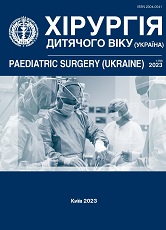Results of the application of an improved prognostic and therapeutic algorithm for the provision of radical surgical care to patients with mechanical jaundice of benign and malignant genesis
DOI:
https://doi.org/10.15574/PS.2023.78.88Keywords:
prognosis, preoperative period, postoperative complications, pancreatic cancer, chronic pancreatitis, molecular-genetic studies, mechanical jaundice, pancreatoduodenal resectionAbstract
The problem of improving the results of surgical care for patients with mechanical jaundice syndrome as a complication of pancreaticobiliary cancer and chronic pseudotumor pancreatitis is still being discussed.
Purpose - to improve the results of radical surgical care for patients with pancreaticobiliary cancer and chronic pseudotumour pancreatitis complicated by mechanical jaundice syndrome.
Materials and methods. The results of surgical treatment of 272 patients with mechanical jaundice syndrome were analyzed. The main group included 112 patients who were treated with our own developed prognostic and therapeutic algorithm. The comparison group included 160 patients who underwent preoperative preparation outside this algorithm.
Results. Almost all the patients in the main group had single nucleotide genetic mutations in the PRSS 1 (Arg122His), SPINK 1 (Asn34Ser), TNF (G308A) and CFTR (Phe508del) genes. In patients of the main group, according to ultrasound elastography, the density of pathological focus for pancreatic cancer was 7.5±0.8 units, and for chronic pseudotumour pancreatitis - 5.6±0.5 units (p<0.05). The most significant differences were observed in the frequency of pancreaticodigestive anastomosis failure (c2=6.95; p=0.008) and in the frequency of bleeding in the postoperative period (c2=4.29; p=0.004). The amount of life-threatening postoperative complications was 42 (37.5%) cases in the main group and 102 (63.8%) cases in the comparison group (c2=18.22; df=1; p<0.0001). In the main group 7 (6.3%) patients died, in the comparison group - 19 (11.9%).
Conclusions. Prevention of the development of immediate postoperative complications in patients with focal pathology of the pancreatobiliary zone against the background of mechanical jaundice is achieved by combining molecular genetic studies with the determination of the patient's phenotype, ultrasound fibroelastography and mathematical modelling of patient status.
The research was carried out in accordance with the principles of the Helsinki Declaration. The study protocol was approved by the Local Ethics Committee of the participating institution. The informed consent of the patient was obtained for conducting the studies.
No conflict of interests was declared by the authors.
References
Alatise OI, Owojuyigbe AM, Omisore AD et al. (2020). Endoscopic management and clinical outcomes of obstructive jaundice. Niger Postgrad. Med. J. 27; 4: 302-310. https://doi.org/10.4103/npmj.npmj_242_20; PMid:33154282
Boiko VV, Kryvoruchko IA, Mushenko YeV, Smachylo RM. (2019). Khirurhichne likuvannia raku pidshlunkovoi zalozy ta peryampuliarnoi zony (stratehichni ta taktychni pytannia). Kharkiv: Promin: 160.
Gupta N, Yelamanchi R. (2021). Pancreatic Adenocarcinoma: A review of recent paradigms and advances in epidemiology, clinical diagnosis and management. World J Gastroenterol. 27; 23: 3158-3181. https://doi.org/10.3748/wjg.v27.i23.3158; PMid:34163104 PMCid:PMC8218366
Hossain AB, Afroz S, Shovon MTK, Anjuman N, Chackraborty. M. (2021). Whipple's pancreaticoduodenectomy: perioperative outcomes in a tertiary care hospital in Dhaka, Bangladesh. Int. J. Res. Med. Sci. 9; 3: 695-700. https://doi.org/10.18203/2320-6012.ijrms20210868
Kopchak BM, Zaivelieva YuI. (2020). Rak pidshlunkovoi zalozy: ukrainski ta svitovi tendentsii. Praktychna onkolohiia. 3; 1: 42-45. (online). https://doi.org/10.22141/2663-3272.3.1.2020.209824
Nagino M, Hirano S, Yoshitomi H et al. (2021). Clinical practice guidelines for the management of biliary tract cancers 2019: The 3rd English edition. J. Hepatobiliary Pancreat. Sci. 28; 1: 26-54. https://doi.org/10.1002/jhbp.870; PMid:33259690
Pancreatic Cancer. (2021). NCCN Guidelines for Pancreatic Cancer. URL: http://www.nccn.org/professionals/physician_gls/pdf/pancreatic.pdf.
Shen Z, Zhang J, Zhao S et al. (2020). Preoperative biliary drainage of severely obstructive jaundiced patients decreases overall postoperative complications after pancreaticoduodenectomy: A retrospective and propensity score-matched analysis. Pancreatology. 20; 3: 529-536. https://doi.org/10.1016/j.pan.2020.02.002; PMid:32107192
Stoyeva TV, Dzhahiashvili OV, Melnychenko MH, Hudz VA. (2019). Using mathematical modeling in the differential diagnosis of acute abdominal syndrome in children Paediatric surgery. Ukraine. 1 (62): 47-52. https://doi.org/10.15574/PS.2019.62.47
Weng Y et al. (2020). Oncological outcomes of robotic-assisted versus open pancreatoduodenectomy for pancreatic ductal adenocarcinoma: a propensity score-matched analysis. Surgical Endoscopy. 35 (7): 3437-3448. https://doi.org/10.1007/s00464-020-07791-2; PMid:32696148 PMCid:PMC8195757
Downloads
Published
Issue
Section
License
Copyright (c) 2023 Paediatric Surgery (Ukraine)

This work is licensed under a Creative Commons Attribution-NonCommercial 4.0 International License.
The policy of the Journal “PAEDIATRIC SURGERY. UKRAINE” is compatible with the vast majority of funders' of open access and self-archiving policies. The journal provides immediate open access route being convinced that everyone – not only scientists - can benefit from research results, and publishes articles exclusively under open access distribution, with a Creative Commons Attribution-Noncommercial 4.0 international license(СС BY-NC).
Authors transfer the copyright to the Journal “PAEDIATRIC SURGERY.UKRAINE” when the manuscript is accepted for publication. Authors declare that this manuscript has not been published nor is under simultaneous consideration for publication elsewhere. After publication, the articles become freely available on-line to the public.
Readers have the right to use, distribute, and reproduce articles in any medium, provided the articles and the journal are properly cited.
The use of published materials for commercial purposes is strongly prohibited.

